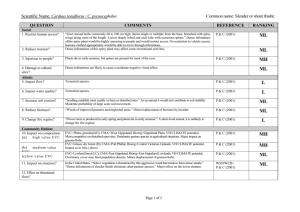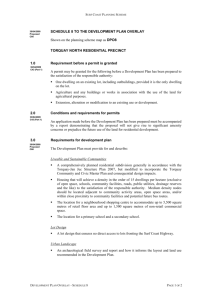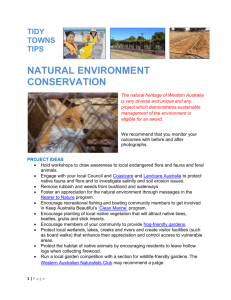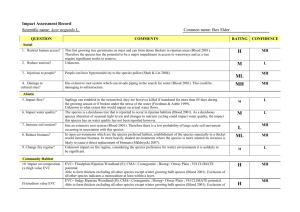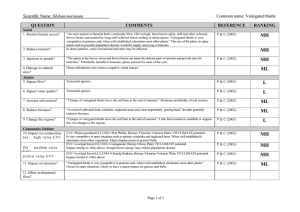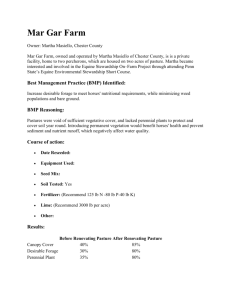QUESTION COMMENTS REFERENCE RANKING Social 1. Restrict
advertisement
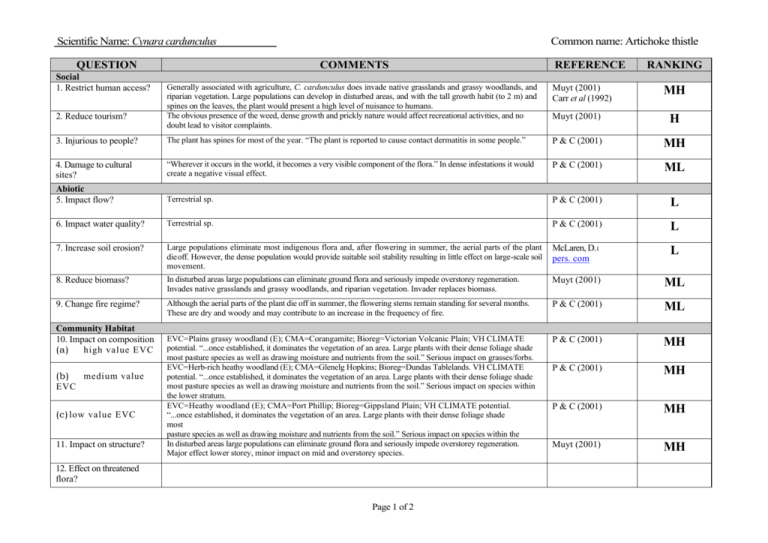
Scientific Name: Cynara cardunculus QUESTION Social 1. Restrict human access? 2. Reduce tourism? Common name: Artichoke thistle COMMENTS Generally associated with agriculture, C. cardunculus does invade native grasslands and grassy woodlands, and riparian vegetation. Large populations can develop in disturbed areas, and with the tall growth habit (to 2 m) and spines on the leaves, the plant would present a high level of nuisance to humans. The obvious presence of the weed, dense growth and prickly nature would affect recreational activities, and no doubt lead to visitor complaints. REFERENCE Muyt (2001) Carr et al (1992) RANKING MH Muyt (2001) H 3. Injurious to people? The plant has spines for most of the year. “The plant is reported to cause contact dermatitis in some people.” P & C (2001) MH 4. Damage to cultural sites? “Wherever it occurs in the world, it becomes a very visible component of the flora.” In dense infestations it would create a negative visual effect. P & C (2001) ML Abiotic 5. Impact flow? Terrestrial sp. P & C (2001) L 6. Impact water quality? Terrestrial sp. P & C (2001) L 7. Increase soil erosion? Large populations eliminate most indigenous flora and, after flowering in summer, the aerial parts of the plant die off. However, the dense population would provide suitable soil stability resulting in little effect on large-scale soil movement. McLaren, D.1 pers. com L 8. Reduce biomass? In disturbed areas large populations can eliminate ground flora and seriously impede overstorey regeneration. Invades native grasslands and grassy woodlands, and riparian vegetation. Invader replaces biomass. Muyt (2001) ML 9. Change fire regime? Although the aerial parts of the plant die off in summer, the flowering stems remain standing for several months. These are dry and woody and may contribute to an increase in the frequency of fire. P & C (2001) ML EVC=Plains grassy woodland (E); CMA=Corangamite; Bioreg=Victorian Volcanic Plain; VH CLIMATE potential. “...once established, it dominates the vegetation of an area. Large plants with their dense foliage shade most pasture species as well as drawing moisture and nutrients from the soil.” Serious impact on grasses/forbs. EVC=Herb-rich heathy woodland (E); CMA=Glenelg Hopkins; Bioreg=Dundas Tablelands. VH CLIMATE potential. “...once established, it dominates the vegetation of an area. Large plants with their dense foliage shade most pasture species as well as drawing moisture and nutrients from the soil.” Serious impact on species within the lower stratum. EVC=Heathy woodland (E); CMA=Port Phillip; Bioreg=Gippsland Plain; VH CLIMATE potential. “...once established, it dominates the vegetation of an area. Large plants with their dense foliage shade most pasture species as well as drawing moisture and nutrients from the soil.” Serious impact on species within the lower stratum. In disturbed areas large populations can eliminate ground flora and seriously impede overstorey regeneration. Major effect lower storey, minor impact on mid and overstorey species. P & C (2001) MH P & C (2001) MH P & C (2001) MH Muyt (2001) MH Community Habitat 10. Impact on composition (a) high value EVC (b) medium value EVC (c) low value EVC 11. Impact on structure? 12. Effect on threatened flora? Page 1 of 2 Scientific Name: Cynara cardunculus QUESTION Fauna 13. Effect on threatened fauna? 14. Effect on nonthreatened fauna? Common name: Artichoke thistle COMMENTS In natural environments it is most likely to establish dense infestations in disturbed areas. It also tends to colonise in medium to large populations. In those situations, the presence of the weed would have a significant impact on the habitat of non-threatened fauna. Spiny nature of plant would deter grazing. REFERENCE RANKING 15. Benefits fauna? “Small birds feed on the seeds.” Bird species not mentioned. Limited food source. Carr et al (1992) Muyt (2001) P & C (2001) P & C (2001) 16. Injurious to fauna? The plant has spines for most of the year. Potential for injury. P & C (2001) H “Small birds feed on the seeds.” Bird species not mentioned. Limited food source. Mice are known vectors for seed dispersal. P & C (2001) ML Pest Animal 17. Food source to pests? 18. Provides harbor? Agriculture 19. Impact yield? No evidence of plant providing harbor for pest animals. ML MH L In permanent pastures C. cardunculus can dominate the vegetation. “Its spiny nature deters sheep and cattle from grazing on heavy infestations but, when hungry, animals will eat the leaves and survive on them.” “It has low nutrient value and may cause stomach impaction and mechanical injuries.” Potential for high impact on yield. No recorded impact on quality. P & C (2001) Dept. of Ag. WA2 21. Affect land value? Heavily infested pasture requires mechanical and/or chemical control to re-establish desired pasture spp. Presence of weed would have some minor influence on land value. P & C (2001) M 22. Change land use? Control practices can be incorporated into existing pasture use. Change in land use would not be required. P & C (2001) L 23. Increase harvest costs? In Western Australia, the weed has occurred in cropping situations where it, “...impedes harvesting.” Dept. of Ag. WA M 24. Disease host/vector? None evident. 20. Impact quality? H L L McLaren, David Dr. Program Leader-Weeds of Agricultural Ecosystems, Keith Turnbull Research Institute. Personal communication 18/03/03 Department of Agriculture, Western Australia, nd., Agriculture Protection Program - Artichoke thistle, http://www.agric.wa.gov.au/agency/pubns/infonote/infonotes/aoo687.htm, viewed 18/03/03 1 2 Page 2 of 2

